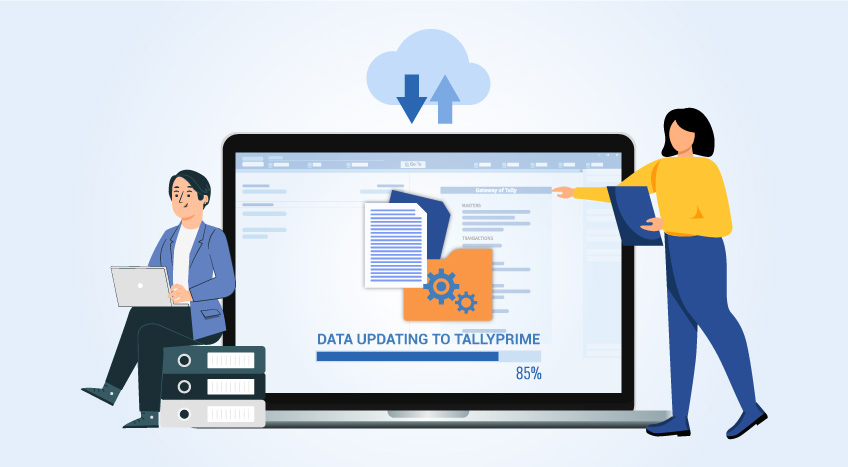Pramit Pratim Ghosh |Updated on: December 28, 2021
Introduction
It may be noted that as per the initial notification issued by the government on 26th June 2017, the provisions of TDS and TCS under GST were put on hold and it was communicated that the same will come into force at a later date.
However, the GST Council, at its 21st meeting in Hyderabad, decided to open registration of persons liable to deduct TDS and TCS under GST from 18th September. However, the date from which TDS and TCS under GST will be deducted or collected will be notified by the Council later, as per the latest tax provisions under GST.
TDS under GST
What is the rate of TDS under GST?
TDS under GST law, is to be deducted at the rate of 1% on payments made to the supplier of taxable goods and/or services, where the total value of such supply, under an individual contract, exceeds INR 2,50,000. However, it is to be noted that no tax deduction is required where the location of supplier and place of supply is different from the State where the recipient is registered.
What is the value of supply on which TDS shall be deducted under GST?
For the purpose of tax deducted at source under GST, the value of supply is to be taken as the amount excluding the tax indicated in the invoice. This means TDS shall not be deducted on the CGST, SGST/UTGST or IGST component of the invoice.
Who needs to deduct TDS under GST?
As per the GST law, the following people/entities need to deduct TDS:
- A department or establishment of the Central or State Government
- Local Authority
- Governmental Agencies
- Persons or category of persons as may be notified, by the Central or a State Government on the recommendations of the Council
How to get registered as a TDS Deductor under GST?
The registration application for a TDS Deductor can be filed electronically by submitting a duly signed application in the Form GST REG 07. In the place of PAN, such persons will indicate their TAN in the registration application. Obtaining TAN (Tax Deduction Account Number) issued under income tax act is mandatory.
The registration application of the applicant will then be processed and approved by the relevant tax officer, post which the registration certificate containing the number, will be issued.
What rules do TDS deductors need to follow under GST?
- Take mandatory GST registration
- Obtain TAN issued under the Income Tax Act is mandatory
- Remit the TDS collected by the 10th day of the month succeeding the month in which TDS was collected and reported in GSTR 7. Based on this, the amount deposited as TDS will be reflected in the electronic cash ledger of the supplier
- Issue a certificate of TDS to the deductee within 5 days of deducting TDS mentioning therein the contract value, rate of deduction, amount deducted, and the amount paid to the appropriate Government and such particulars as may be prescribed. If any deductor fails to furnish to the deductee the certificate, after deducting the TDS within five days of crediting the amount so deducted to the appropriate Government, the deductor shall be liable to pay, by way of a late fee, a sum of INR 100 per day from the day after the expiry of the five-day period until the failure is rectified. The amount of late fee, shall not exceed INR 5,000.
- Adhere to the rules, since non-deduction / short deduction / non-payment or short payment of TDS is an offence under the Act for which a minimum penalty of INR 10,000 is prescribed
How can the deductee claim benefit of TDS under GST?
The deductee shall claim credit, in his electronic cash ledger, of the tax deducted and reflected in the returns of the deductor. Any amount deducted as TDS and reported in GSTR 7 will automatically reflect in the electronic cash ledger.
In case the amount is claimed by deductee in electronic cash ledger
Refund to the deductor is not possible in such a case. However, deductee can claim a refund of tax subject to refund provisions of the Act. Practically it is not possible to claim any erroneous deduction of TDS by the deductor.
In case the amount is not claimed by deductee
Refund of the erroneous excess TDS deducted is possible to the deductor, subject to the refund provisions and procedure of the Act.
TCS under GST
What is the rate of TCS under GST?
Any dealer / trader selling goods or services online will get the payment after deduction of 2% TCS.
Who needs to deduct TCS under GST?
Under GST, the main TCS deductors are the e-commerce aggregators, who are made responsible for deducting and depositing TCS at the rate of 2% from each of the transaction.
What rules do TCS deductors need to follow under GST?
- Take mandatory GST registration – which is true both for persons making supplies through e-commerce operators as well as e-commerce operators themselves
- Remit the TCS collected by the 10th day of the month succeeding the month in which TCS was collected and reported in GSTR 8
- File an annual statement in the prescribed form by the 31st of December following the end of every financial year. The operator can rectify errors in the statements filed, if any, latest by the return to be filed for the month of September, following the end of every financial year. The details furnished by the operator in GSTR 8 shall be made available electronically to each of the suppliers in GSTR 2A after the due date of filing of GSTR 8
- Furnish details of volume of goods / services supplied, stock of goods lying in warehouses or godown etc. whenever asked for, by an officer not below the rank of Deputy Commissioner, within a period of 15 working days. Failure to do so may fetch penalty up to INR 25,000
How can the Supplier claim benefit of TCS under GST?
The tax collected by the operator shall be credited to the electronic cash ledger of the supplier who has supplied the goods/services through the operator. The supplier can claim credit of the tax collected and reflected in the return by the operator in the supplier’s electronic cash ledger.
Who is liable to pay the additional output TCS under GST in case of discrepancy?
The details of the supplies, including the value of supplies, submitted by every operator in the statements will be matched with the details of supplies submitted by all such suppliers in their returns. If there is any discrepancy in the value of supplies, the same would be communicated to both of them. If such discrepancy in value is not rectified within the given time, then such amount would be added to the output tax liability of such a suppler. The supplier will have to pay the differential amount of output tax along with interest.
Read More on GST
GST Software, GST Software for CAs, GST Software for Traders, GST Invoicing Software, GST Calculator, GST on Freight, GST on Ecommerce, GST Impact on TCS, GST Impact on TDS, GST Exempted Goods & Services, Reverse Charge Mechanism in GST, GST Declaration
GST Rates & Charges
GST Rates, GST Rate Finder, GST Rate on Labour Charges, HSN Codes, SAC Codes, GST State Codes
Types of GST
CGST, SGST, IGST, UTGST, Difference between CGST, SGST & IGST
GST Returns
GST Returns, Types of GST Returns, New GST Returns & Forms, Sahaj GST Returns, Sugam GST Returns, GSTR 1, GSTR 2, GSTR 3B, GSTR 4, GSTR 5, GSTR 5A, GSTR 6, GSTR 7, GSTR 8, GSTR 9, GSTR 10, GSTR 11
Latest Blogs

How to Easily Shift/Migrate Your Data to TallyPrime

Nuts & Bolts of Tally Filesystem: RangeTree

A Comprehensive Guide to UDYAM Payment Rules

UDYAM MSME Registration: Financial Boon for Small Businesses

Understanding UDYAM Registration: A Comprehensive Guide

MSME Payment Rule Changes from 1st April 2024: A Quick Guide

